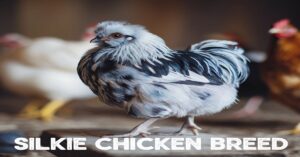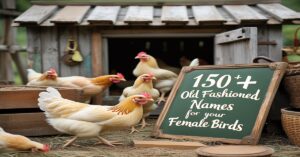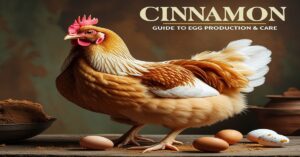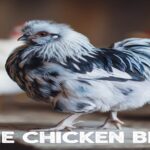The White Leghorn chicken is among the most well-known and widely kept breeds in the world. Their superior egg-laying capabilities, active nature, and adaptability to warmer climates make them a go-to breed for poultry enthusiasts and commercial egg producers alike. This breed, with its crisp white feathers and yellow legs, is easily recognized and respected in the poultry world.
If you’re considering raising White Leghorns for eggs or simply want to understand more about them, this comprehensive guide will provide all the information you need, from history and physical characteristics to care requirements and breeding tips.
Here’s a table summarizing key facts and figures about the White Leghorn chicken:
| Category | Fact |
|---|---|
| Origin | Tuscany, Italy |
| Breed Recognition | American Poultry Association (1870s) |
| Egg Production Rate | 280–320 eggs per year (4+ eggs/week) |
| Egg Color | White |
| Egg Size | Large |
| Start of Egg Production | 18–24 weeks |
| Egg Production Decline | 10–15% per year after the first year of laying |
| Rooster Weight | 8 lbs (3.6 kg) |
| Hen Weight | 5 lbs (2.3 kg) |
| Average Lifespan | 4–6 years in backyard flocks, 2–3 years in commercial farms |
| Comb Type | Single comb (large, upright) |
| Wattles | Red |
| Earlobes | White |
| Legs | Yellow, bare |
| Tail | Long, pointed, slightly curved upward |
| Temperament | Flighty, gentle, skittish (hens), aggressive (roosters) |
| Heat Tolerance | High (due to large combs for cooling) |
| Cold Tolerance | Low (risk of frostbite) |
| Space Requirements (Coop) | 4 square feet per bird |
| Space Requirements (Run) | 10 square feet per bird |
| Noise Level | Noisy (frequent squawking, crowing) |
| Common Health Issues | Frostbite, calcium deficiency, parasites, aggressive behavior |
| Breed Purpose | Primary: Egg production, Secondary: Meat production (minimal) |
| Broodiness | Rare |
Introduction to the White Leghorn Chicken
The White Leghorn chicken is a perfect example of efficiency in the world of poultry. With its impressive egg-laying ability and adaptable nature, it is a breed that offers a high return on investment, especially for egg producers. White Leghorns are highly valued for their prolific egg production, capable of producing between 280 to 320 eggs per year, making them ideal for farmers looking for consistent output.
Their physical characteristics also contribute to their popularity, including their light weight, sleek white feathers, and yellow legs. White Leghorns are extremely active, with a flighty disposition, meaning they prefer free-range environments where they can roam and forage for food. This breed thrives in environments with mild to warm climates, making them less suited for extreme winters, but perfect for warmer regions.
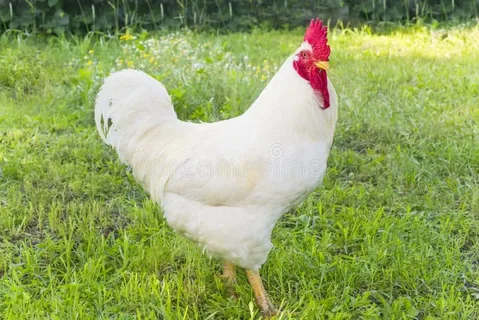
Why White Leghorns Are Popular Among Poultry Keepers
One of the standout qualities of White Leghorns is their exceptional egg production. These chickens are among the most prolific layers in the poultry world, often producing large white eggs. Compared to other chicken breeds, Leghorns are early layers, often beginning to lay eggs around 18 to 24 weeks of age. This early start means they can start contributing to egg production almost as soon as they are mature enough.
Beyond their egg-laying capabilities, White Leghorns are also low-maintenance. They do not require much space and can easily adapt to smaller coops as long as their basic needs are met. Their ability to withstand heat and their general resistance to disease make them an excellent choice for both beginners and experienced poultry farmers. They are active foragers, which means they can find a good portion of their food when allowed to roam, thus reducing feed costs.
History and Origin of the Leghorn Chicken
The Leghorn chicken breed has its origins in the region of Tuscany, Italy. Its development dates back to the early 1800s, where it was selectively bred for its ability to produce a high number of eggs. The breed’s name is believed to come from the port of Livorno, which was once known as Levorno in English. It is thought that sailors from England and other European countries encountered this breed during trade, and they brought it back to their home countries.
By the time it reached the United States in the early 19th century, the Leghorn chicken had already gained a reputation as a prolific egg-layer. American poultry breeders quickly recognized its value, and the breed was officially recognized by the American Poultry Association in the 1870s.
Evolution and Spread of the Breed
Over the years, the Leghorn breed has diversified into several different color variants, including Barred, Black, Buff, Columbian, and White. However, the White Leghorn remains the most popular variant due to its consistent and clean appearance. The White Leghorn’s distinctive white feathers and yellow legs are ideal for commercial egg production, where cleanliness and ease of collection are key priorities.
As industrial poultry farming grew in the 20th century, White Leghorns became the go-to breed for mass egg production. The breed was selectively bred for maximum productivity, and its efficiency in egg-laying led to it being used in commercial farms worldwide. Despite this, the White Leghorn still thrives in backyard flocks, where its independent nature and hardworking habits make it a favorite among hobbyists and small-scale farmers.
White Leghorn Chicken: Heritage Breed or Hybrid?
While the Leghorn chicken has become synonymous with commercial egg production, it is not a hybrid breed. White Leghorns are a heritage breed, meaning they have not been artificially bred by crossing different breeds for specific traits. Instead, they are the result of selective breeding over many years to enhance traits like high egg production, heat tolerance, and resilience.
Hybrids, on the other hand, are intentionally bred by crossing different chicken breeds to emphasize specific qualities, such as increased egg output or faster growth rates. While some modern egg-laying hybrids are bred for maximum egg production, Leghorns maintain their status as a heritage breed due to their long-standing history and established characteristics.
Leghorns have remained remarkably consistent in terms of their physical traits, such as their white feathers, yellow legs, and single comb. These traits are part of what makes them so recognizable and have contributed to their success both in commercial farming and as backyard chickens.
Physical Characteristics of White Leghorns
The physical characteristics of the White Leghorn breed are well-suited to their needs in the poultry world. They are relatively small, lightweight birds that are highly active and excellent foragers. Here’s a closer look at their distinctive physical features:
- Feathers: White Leghorns are covered in sleek white feathers, which are lightweight and perfect for hot climates. Their feathering helps them stay cool in warmer weather, making them ideal for areas with high temperatures. The clean white color of their feathers is also appealing to farmers, as it provides a tidy appearance.
- Comb: White Leghorns have a single comb, which is large, upright, and typically bright red. The single comb is an important feature because it helps regulate the bird’s body temperature. It serves as a heat-dissipation mechanism in warmer climates. This is why Leghorns are well-suited to hotter regions.
- Wattles: These chickens also have red wattles that hang from the sides of their beaks. Like their comb, the wattles help with thermoregulation by allowing the bird to shed excess heat.
- Earlobes: The white earlobes of the White Leghorn stand in stark contrast to their bright red combs and wattles. Though not typically a focal point for most poultry keepers, their white earlobes are a distinctive feature of the breed.
- Legs: The yellow legs of the White Leghorn are another identifying characteristic. Their legs are bare, meaning they lack feathers, which further helps them stay cool in hot weather.
- Tail: White Leghorns have long, pointed tails that curve upwards slightly, adding to their elegant appearance. The tail is often held high, giving the bird a proud stance.
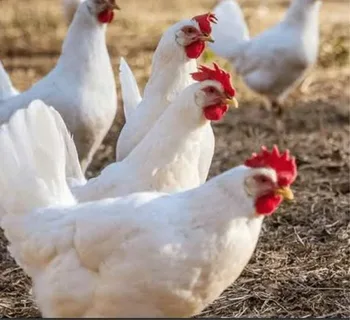
Size and Weight of White Leghorns
White Leghorns are a lightweight breed. Here are the typical weights:
- Roosters: On average, White Leghorn roosters weigh around 8 lbs (3.6 kg). They are taller and more robust than hens but remain relatively light compared to meat breeds.
- Hens: White Leghorn hens are lighter, weighing around 5 lbs (2.3 kg). They are smaller than roosters but still produce large eggs for their size.
The small size of White Leghorns makes them agile and capable of escaping predators if necessary. It also allows them to thrive in smaller spaces, making them suitable for both commercial egg farms and backyard flocks.
White Leghorn Egg-Laying Capabilities
One of the biggest draws of White Leghorn chickens is their remarkable egg-laying ability. These birds are among the top egg producers, consistently laying large white eggs throughout the year. Here’s a breakdown of their egg-laying characteristics:
- Egg Color: The eggs laid by White Leghorns are consistently white, a feature that has led to their widespread popularity in the commercial egg industry. White eggs are often associated with cleanliness, and many consumers prefer them for this reason.
- Egg Size: White Leghorns lay large eggs, which are desirable for cooking, baking, and market sales. The size of their eggs makes them suitable for most culinary purposes.
- Egg Production Rate: White Leghorns can lay anywhere between 280 to 320 eggs per year. This means they can produce about 4+ eggs per week. This impressive rate of egg production is one of the main reasons they are favored by egg producers.
- Start of Egg Production: White Leghorns typically start laying eggs around 18 to 24 weeks of age, which is relatively early compared to many other breeds. This gives farmers an early return on their investment, especially in commercial operations.
- Decline in Production: Like most egg-laying breeds, White Leghorns will experience a slight decline in egg production as they age. After their first year of laying, egg production may decrease by 10 to 15% per year.
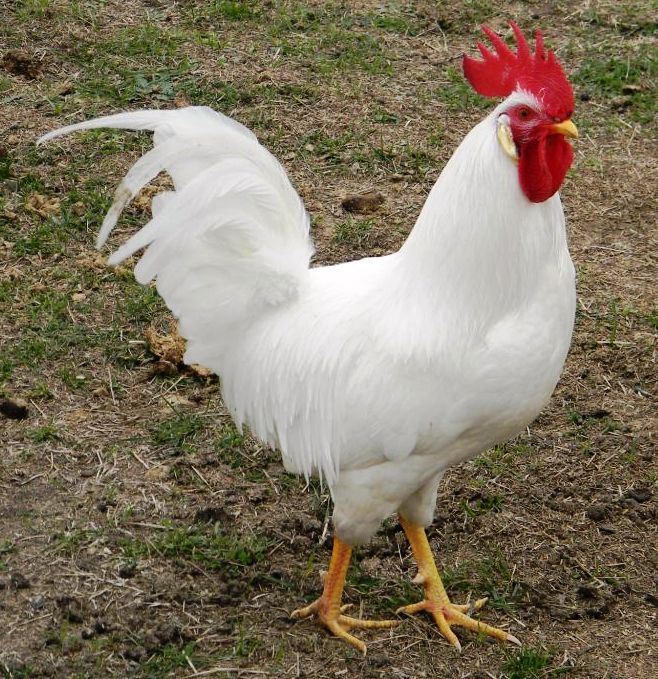
Behavior and Temperament of White Leghorns
White Leghorns are known for their flighty and independent nature. They are highly active birds that enjoy exploring and foraging for food. While this makes them ideal for free-range environments, it also means they may not be the best choice for owners who want to interact with their chickens on a personal level.
Rooster Behavior
White Leghorn roosters are known for being territorial and sometimes aggressive. They can become protective of their flock, especially if they feel threatened. This aggressive behavior can make them difficult to handle in mixed-flock situations, so it’s important to monitor their interactions with other birds.
Hen Behavior
White Leghorn hens, on the other hand, tend to be gentle but can be skittish. They are not as friendly as some other breeds and may not enjoy being handled. However, they are diligent foragers and will happily spend their time searching for food. If raised in a free-range environment, they are content to go about their day without much intervention.
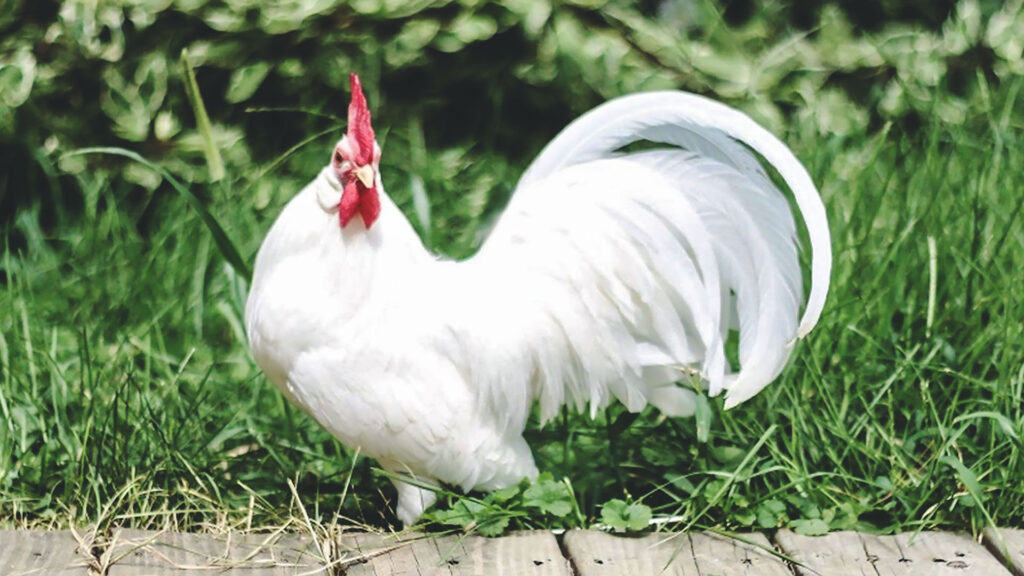
Hardiness and Adaptability
White Leghorns are known for their heat tolerance and adaptability to various environmental conditions. Their large combs and lightweight bodies help them stay cool in hot weather, but they are not as tolerant of cold climates. Here’s how they handle extreme weather conditions:
Heat Tolerance
White Leghorns thrive in warm climates and are well-suited for regions with high temperatures. Their large combs act as a natural cooling system, helping to regulate their body temperature in hot weather. These chickens are generally heat-hardy, making them perfect for areas that experience long, hot summers.
Cold Tolerance
Although White Leghorns are resilient in warmer climates, they are not well-suited to extreme cold. Their lightweight bodies and lack of feathering on their legs make them vulnerable to frostbite in freezing temperatures. If you live in a colder region, it’s essential to provide them with a warm coop and protection from the elements during the winter months.
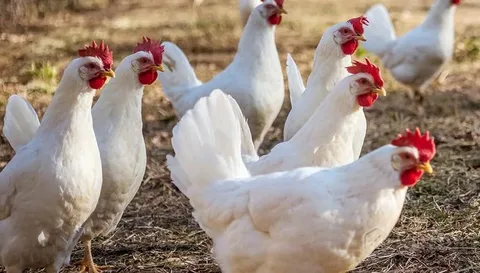
Health Considerations for White Leghorns
Like all chicken breeds, White Leghorns are prone to certain health risks. Regular health checks and proper care can prevent most issues, but it’s important to be aware of potential concerns:
- Frostbite: White Leghorns are susceptible to frostbite due to their large combs and wattles, especially in freezing temperatures. To prevent this, make sure your chickens have access to a well-insulated coop during the winter.
- Calcium Deficiency: Calcium is essential for healthy egg production, and a lack of it can result in soft-shelled eggs or a decline in egg production. Make sure your Leghorns have access to calcium supplements like crushed oyster shells.
- Parasites: Like all poultry, White Leghorns can be prone to parasites, including mites and worms. Regular parasite control measures, such as deworming and dust baths, are important for keeping your flock healthy.
- Aggressive Roosters: Roosters can sometimes become aggressive, especially if they feel their territory is being threatened. It’s important to monitor their behavior and
separate them from the flock if necessary.
Housing Requirements for White Leghorns
White Leghorns need an adequate amount of space to roam and lay eggs comfortably. Here are some housing recommendations for this breed:
- Coop Size: Provide at least 4 square feet per bird in the coop to ensure they have enough room to move around. Leghorns do best in a spacious environment, where they can stretch their wings and remain active.
- Enclosed Run: The run should provide at least 10 square feet per bird. Since Leghorns are active foragers, they will appreciate the space to roam and explore.
- Climate Control: In hot climates, make sure your coop is well-ventilated and provides adequate shade. In cold climates, ensure the coop is windproof and offers protection from frostbite.
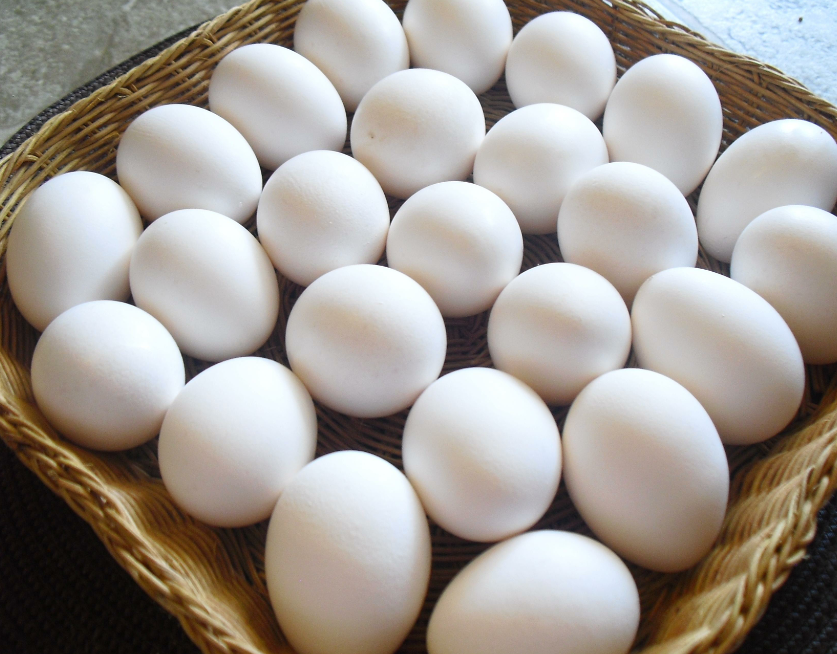
FAQs
Which breed is White Leghorn?
The White Leghorn is a chicken breed that originated in Italy and is renowned for its egg-laying abilities. It is the most important Mediterranean breed today.
What color eggs do White Leghorns lay?
White Leghorns are known for laying white eggs, typically around 280 to 320 each year, with each egg weighing at least 55 grams.
Are White Leghorns good chickens?
White Leghorns are excellent egg layers but can be flighty and require ample space in the coop. They are ideal for free-range environments and are very efficient in terms of feed-to-egg ratio.
Why are Leghorns not for beginners?
Leghorns are not recommended for beginners due to their nervous and noisy temperament. They require space and may not be suitable for urban or suburban settings.
Is White Leghorn a broiler?
White Leghorns are primarily egg layers and are not known for brooding or incubation. They typically lay up to 300 eggs annually.
How long will Leghorns lay eggs?
Leghorns can lay eggs consistently for up to four years, with production slowing down around the age of 6 or 7.
How fast do White Leghorns grow?
White Leghorns grow rapidly and reach maturity in less than a year, showing noticeable growth within a few months.
Do Leghorns lay green eggs?
Leghorns lay white eggs, unlike breeds like Ameraucana that lay blue eggs or Olive Eggers that produce green eggs.
What are the disadvantages of Leghorn chickens?
Leghorns are lightweight and not suitable for meat production. They are also flighty, avoiding human interaction, and are prone to nervousness.
Can White Leghorns fly?
Yes, White Leghorns have strong wings and can fly well, particularly when young and less developed.
Can Leghorns lay 2 eggs a day?
While Leghorns are prolific egg layers, they typically lay one egg per day, averaging about 6 eggs per week, and not two per day.
Are Leghorns aggressive?
Leghorns are generally not aggressive but can be assertive, especially roosters, who may show dominance toward hens.
What is the main use of White Leghorn chickens?
White Leghorns are primarily used for egg production, providing a high yield of large white eggs and contributing to the creation of hybrid egg-layers.
Are White Leghorns noisy?
White Leghorns are quite noisy, with constant chattering and loud squawking, especially when laying eggs or startled.
At what age do White Leghorns stop laying eggs?
White Leghorns begin to slow down their egg production around 6 or 7 years old, though they may still live for several more years.
What are the advantages of White Leghorn chickens?
White Leghorns excel at egg production, are hardy and active, and are suited for free-range environments, though they are not ideal as pets.
Is a White Leghorn a broiler?
White Leghorns are not typically broilers, as they are more focused on egg production and lack the brooding instinct to hatch eggs.
Are White Leghorns aggressive?
While White Leghorn roosters may be assertive with hens, they are usually friendly to humans and not aggressive in nature.
What is the origin of the White Leghorn chicken?
The White Leghorn chicken originated in Tuscany, Italy, and was first recognized by the American Poultry Association in the 1870s.
How many eggs do White Leghorn chickens lay per year?
White Leghorns are prolific egg layers, producing between 280 and 320 eggs annually, with many hens laying nearly one egg per day.
What color eggs do White Leghorns lay?
White Leghorns lay large white eggs, typically weighing 55 grams or more each.
How much do White Leghorn chickens weigh?
Roosters of the White Leghorn breed typically weigh around 8 lbs (3.6 kg), while hens weigh about 5 lbs (2.3 kg).
What is the average lifespan of a White Leghorn chicken?
White Leghorns can live 4 to 6 years in a backyard setting, but their lifespan is shorter in commercial settings, typically 2 to 3 years.
What is the temperament of White Leghorn chickens?
White Leghorns are generally flighty and skittish, with roosters being more assertive and hens being more gentle but wary.
Are White Leghorns suitable for cold climates?
White Leghorns thrive in warmer climates due to their heat tolerance, but they are susceptible to frostbite and not well-suited for cold environments.
Do White Leghorns require a lot of space?
Yes, White Leghorns need ample space, with at least 4 square feet per bird in the coop and 10 square feet per bird in the run.
How long does it take for White Leghorns to start laying eggs?
White Leghorns typically begin laying eggs around 18 to 24 weeks of age.
Are White Leghorns good for meat production?
While White Leghorns can be used for meat, they are primarily egg layers, and their meat yield is minimal compared to other breeds.
What are the common health issues with White Leghorn chickens?
White Leghorns may face health issues such as frostbite, calcium deficiencies, parasites, and occasionally aggressive behavior from roosters.
Are White Leghorns broody?
White Leghorns are not broody and are more focused on egg-laying, rarely attempting to incubate their own eggs.
How noisy are White Leghorns?
White Leghorns are known for being noisy, with frequent squawking and crowing, particularly from the roosters.
What are the space requirements for housing White Leghorns?
Each White Leghorn should have at least 4 square feet in the coop and 10 square feet in the run, with proper ventilation and shade in hot climates.
Conclusion: Are White Leghorns Right for You?
If you’re looking for a high-producing, low-maintenance chicken breed for egg production, then the White Leghorn chicken is an excellent choice. They are hardy, active, and prolific layers, making them ideal for backyard flocks and commercial egg producers alike.
However, keep in mind that White Leghorns are better suited for warmer climates and may not perform as well in extreme cold. Their flighty temperament also means they might not be the best choice for those looking to interact with their chickens regularly.
With their high egg production and low-maintenance care needs, White Leghorns are an excellent investment for anyone interested in raising chickens for eggs. Whether you’re new to poultry-keeping or an experienced farmer, these chickens are sure to make a valuable addition to your flock.
Read more knowledgeable blogs on Flowy Magazine

James Clair is a passionate writer and researcher with a deep fascination for animal behavior and its intricate connection to human life. With a background in [relevant field of study, e.g., zoology, psychology, ethology], James has spent years studying the natural world, focusing on how animals’ actions and instincts impact human emotions, behavior, and society.
His expertise in [specific topics or regions of focus, e.g., canine psychology, animal communication, wildlife conservation] has led to numerous published works and collaborations with renowned researchers and institutions. Through his work at Flawy Magazine, James aims to bridge the gap between scientific research and public understanding, offering insightful, accessible articles that explore the complex relationship between humans and animals.
When he’s not writing, James enjoys [personal hobbies or interests, e.g., hiking in nature, volunteering at animal shelters, photography] and is an advocate for [cause or charity related to animals or conservation]. His mission is to inspire readers to see animals not just as companions or creatures of the wild, but as beings whose behavior holds valuable lessons for us all.



